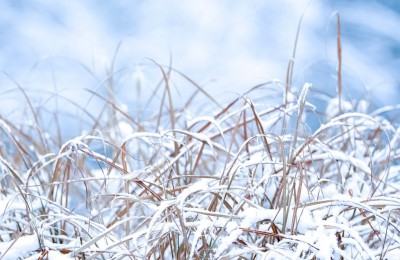Tips on Grazing After a Frost or Freeze
Amy Barkley, Livestock Specialist
Southwest New York Dairy, Livestock and Field Crops Program

Freezing Effects on Forages
Written by the University of Kentucky
Prussic Acid (Cyanide) Poisoning
As temperatures continue to decrease, it is important to know and understand how various species of forages react to frosts and freezes in order to best utilize these forages and to avoid possible health problems. Freezing changes the metabolism and composition of plants. Depending on plant species, this can create possible forage-related animal disorders or the need to alter grazing management practices.
Plants such as sorghum, sudangrass, sorghum-sudan hybrids, Johnsongrass, wild cherry, and others contain cyanide-producing compounds. When these plants are damaged by frost or drought conditions, a reaction produces larger quantities of cyanide. It is important to use extreme caution when grazing these species during damaging conditions. Soils high in nitrogen and low in phosphorous have greater potential of producing harmful levels of cyanide. Leaves, new shoots, and tillers have higher levels of cyanide If there is a non-killing frost, wait 10-14 days with no additional frost action before grazing. It is advised to keep livestock off these pastures for up to three days after a killing frost.
If large amounts of cyanide, often referred to as prussic acid, are consumed, the compound interferes with oxygen utilization and livestock can die from respiratory paralysis. Symptoms appear quickly after forage is consumed. These symptoms may include cherry red colored blood, staggering, labored breathing, spasms, foaming at the mouth, falling, thrashing, severe convulsions, and death. Immediate treatment by a veterinarian is needed to save livestock suffering from cyanide poisoning.
When cut for hay, cyanide content decreases significantly during the curing process. A fair amount of this poison escapes as gas during fermentation when used for silage. Although it is usually safe to feed these species as hay or silage, it is important to be cautious when grazing any forage that can potentially have high cyanide levels.
Using caution when grazing these forages during times of stress can usually eliminate the possibility of cyanide poisoning in livestock. Wait the recommended time before grazing after a frost. Mixing nonthreatening forages into the diet can be beneficial as well. Using "test" animals is another option rather than turning the whole herd onto a field.
The risk of cyanide poisoning this season can be reduced by following these practices:
- Wait 10-14 days after non-killing frost with no additional frost action before grazing.
- Do not graze after a killing frost until plant material is dry (the toxin usually dissipates within 72 hours.)
- Do not graze at night when frost is likely. High levels of toxins are produced within hours after frost occurs.
- Delay feeding silage for six to eight weeks following ensiling.
See http://www.uky.edu/Ag/Forage/GL%20ASC-57.pdf for more information on forage-related livestock disorders.
Effects of Freeze on Alfalfa
A few other commonly used forages, including alfalfa, are affected by freeze which may affect best management strategies. Although frost damaged alfalfa is not toxic, it is important to be cautious when grazing alfalfa after a hard freeze (less than 25F). After a freeze, the threat of bloat slightly increases for a few days. Once wilting starts or the plant starts growing again, bloat is less likely. Waiting a few days after a freeze can be a good practice to decrease risk of bloat when grazing alfalfa. Continue to use recommended practices to reduce the potential for bloat. If forage is needed and you plan to cut the alfalfa for hay, it is suggested to wait to cut until the first hard freeze or until early to mid-November (even without a freeze there is very little regrowth after this date). After a hard freeze occurs, cut as soon as possible to reduce losses in nutritive value. If cut after a non-killing freeze, plants can start to regrow which will use stored carbohydrates that would otherwise be used for overwintering and spring regrowth.
Grazing Tall Fescue after a Freeze
Damaging frosts significantly reduce forage quality in most forage species. Tall fescue is unique because it has waxy layer which lessens the damage caused by colder temperatures and forage quality remains high in comparison to other species. The quality loss from leaf deterioration is lower compared to other cool-season forages. Another unique attribute of tall fescue is that after experiencing a freeze, sugar content increases. This makes tall fescue ideal for stockpiling and winter grazing use.

Use caution when grazing certain warm-season grasses after a frost to reduce risk of cyanide (prussic acid) poisoning
The original article can be found here: https://grazer.ca.uky.edu/cont...
Upcoming Events
WEBINAR - Automated Milking Systems Efficiency: Balancing Focus on Individual Cows and System Optimization
May 8, 2024
Please join Cornell the SWNY team and MSU Extension for our talk with Dr. Pablo Silva Boloña on improving efficiency of Automated milking systems by focusing on milking settings for individual and group success.
Broiler Field Day at Sunny Cove Farm
June 6, 2024
Alfred Station, NY
Join us for a field day to explore broiler production, processing, and finances. Meghan Snyder of Sunny Cove Farm will be our host. She raises small batches of organic broilers, processing them on-farm under the 1,000 bird exemption.
Stockmanship and Stewardship 2024
October 25, 2024
Hamburg, NY
Save the date!! The event is one of 4 across the US and is a two-day educational experience featuring low-stress cattle handling demonstrations, Beef Quality Assurance educational sessions, facility design sessions, and industry updates.
Announcements
No announcements at this time.





